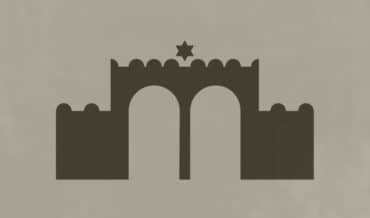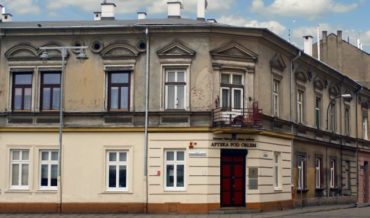Contents
Key Facts
- Born in 1919 in Krakow into a Jewish family with strong Zionist connections
- Son of Szymon Bauminger, a prominent leader of the Zionist-orthodox party Mizrach
- Active member of Jewish youth organizations: Haszomer Hadati and later Haszomer Hacair
- Polish Army veteran who fought in the September Campaign of 1939
- Soviet Army sergeant who served on the Ukrainian front during WWII
- Escaped German captivity near Kharkiv and walked across occupied territory to return to Krakow
- Leader of the Jewish Fighting Unit in the Krakow Ghetto
- Killed in February 1943 during a Gestapo operation in Prądnik Biały
Early Life and Political Formation
Hersz Bauminger was born in 1919 in Krakow into a politically active Jewish family that would profoundly shape his future commitment to resistance. His father, Szymon Bauminger, was one of the prominent leaders of Mizrach, a Zionist-orthodox political party that sought to combine religious Jewish traditions with the modern Zionist movement¹. This family background provided young Hersz with both a strong Jewish identity and an early exposure to political activism that would prove crucial in his later resistance work.
During his formative teenage years, Hersz became an active member of Haszomer Hadati, a religious Zionist youth movement that emphasized both Jewish religious education and physical training. This organization combined traditional Jewish learning with modern scouting activities, preparing young Jews for potential emigration to Palestine while maintaining their religious observance². The skills he learned in Haszomer Hadati – including outdoor survival, group organization, and leadership – would later prove invaluable during his resistance activities. His religious education connected him to the broader Jewish heritage of Krakow, a city with centuries of Jewish history reflected in its historic synagogues in Krakow.
As Hersz matured politically, he transitioned to the more radical Haszomer Hacair, a left-wing Zionist youth movement that advocated for socialist principles and more militant approaches to achieving Jewish national goals³. This shift reflected his growing political sophistication and willingness to embrace more confrontational methods in pursuit of Jewish liberation, foreshadowing his later involvement in armed resistance.
Military Service and War Experience
The September Campaign of 1939
In 1939, Hersz was called up to serve in the Polish Army and participated in the September Campaign, the brief but fierce defense of Poland against the simultaneous German and Soviet invasions. This campaign, lasting from September 1 to October 6, 1939, saw the rapid collapse of Polish military resistance despite heroic efforts by individual units and soldiers⁴. Bauminger's participation in this campaign gave him valuable military experience and firsthand knowledge of German military tactics and organization. His military service during this period connected him to the broader Polish resistance tradition later exemplified by figures like Józef Piłsudski, who had shaped Poland's military heritage.
Following Poland's defeat, he found himself in territory that came under Soviet occupation, as per the Molotov-Ribbentrop Pact that had secretly divided Poland between Nazi Germany and the USSR. This placement in the Soviet zone initially provided him with relative safety compared to Jews in German-occupied territories, though it also meant separation from his family and home in Krakow.
Service in the Soviet Army
Initially working as a civilian driver in Stanisławów (now Ivano-Frankivsk, Ukraine), Bauminger's situation changed dramatically after June 22, 1941, when Germany launched Operation Barbarossa against the Soviet Union⁵. As the German army advanced eastward, he was mobilized into the Soviet Army with the rank of sergeant, joining the desperate defense of Soviet territory against the German invasion.
Fighting on the Ukrainian front as a sergeant in the Soviet Army, Bauminger experienced the brutal reality of the Eastern Front, where millions of soldiers and civilians would perish in what became the most destructive theater of World War II. His service demonstrated both his military capabilities and his commitment to fighting fascism, even before he became directly involved in specifically Jewish resistance activities.
Near Kharkiv, he fell into German captivity but managed to escape – a feat that required both courage and cunning, as German treatment of Soviet prisoners of war was notoriously harsh, with millions dying in captivity⁶. His successful escape demonstrated the resourcefulness and determination that would characterize his later resistance work.
The Dangerous Journey Home
Disguising his identity as Ukrainian, he traversed hundreds of kilometers of occupied territory from Kharkiv through Lviv to reach Krakow – an extraordinarily dangerous journey through Nazi-occupied Poland⁷. This journey required not only physical endurance but also linguistic skills, quick thinking, and an intimate knowledge of local customs to maintain his false identity. The fact that he successfully completed this journey while German security forces were actively hunting escaped prisoners of war and conducting anti-partisan operations demonstrates his exceptional abilities as a clandestine operative.
Resistance Leadership in Krakow
Entering the Ghetto
Upon reaching Krakow, Bauminger made the deliberate decision to enter the Krakow Ghetto – a remarkable choice that demonstrated his commitment to fighting alongside his fellow Jews rather than remaining safely hidden with false identity papers. The Krakow Ghetto, established in March 1941 in the Podgórze district, confined approximately 15,000-20,000 Jews in severely overcrowded conditions⁸. This area, across the river from Krakow's historic old town of Krakow, became the center of both persecution and resistance.
He immediately joined the resistance movement upon entering the ghetto, bringing his military experience and knowledge of German operations to the underground organization. His contacts within the resistance network helped him secure employment at a German garage, which provided him with official authorization to leave the ghetto territory – a crucial advantage that allowed him to coordinate between resistance cells inside and outside the ghetto walls⁹.
The Jewish Fighting Unit
Bauminger became a leader of the Jewish Fighting Unit (Żydowski Związek Walki), one of the primary Jewish resistance organizations operating in occupied Krakow¹⁰. This organization worked to organize armed resistance during the Holocaust, contradicting post-war misconceptions about Jewish responses to persecution. His resistance activities paralleled those documented and commemorated at the Home Army Museum, which honors the broader Polish resistance movement.
Historical records document that the resistance activities under his leadership included:
- Organizing sabotage operations against German military and economic targets
- Eliminating collaborators and informants who threatened the safety of resistance networks
- Setting fire to German storehouses and garages, disrupting enemy logistics and supply chains
- Derailing trains carrying German military supplies and personnel
- Attacking German soldiers and police to capture weapons and ammunition¹¹
These operations required careful intelligence gathering, precise planning, and considerable personal courage, as capture meant certain death, often after brutal interrogation. The resistance network operated throughout the city, even as Jews from surrounding areas were being transported to nearby camps like Auschwitz-Birkenau and the Plaszow concentration camp.
Final Days and Death
The February 1943 Operation
At the end of February 1943, Bauminger was located by the Gestapo at one of his hiding places in Prądnik Biały, a district in northern Krakow where resistance members maintained safe houses¹². This location, outside the main ghetto area, indicates the network of hiding places and support systems that the Jewish resistance had developed throughout the city. During this period, few resources existed to help ghetto residents, with notable exceptions like the Eagle Pharmacy, which provided assistance to Jews despite the enormous risks involved.
The Gestapo operation that led to his discovery was likely the result of intensive surveillance, infiltration by informants, or information extracted under torture from captured resistance members. By early 1943, German security forces had become increasingly effective at penetrating resistance networks through these methods.
Disputed Accounts of His Death
The exact circumstances of Bauminger's death remain a subject of historical debate, with survivor testimonies providing different versions of events:
-
According to one documented account, he took his own life before being captured, choosing death over the risk of revealing information under torture that could endanger other resistance members – a decision reflecting the extreme dedication characteristic of resistance fighters¹³.
-
According to alternative testimony, he was captured alive and subsequently executed at Montelupich prison – the notorious German detention facility in Krakow where thousands of Polish resistance fighters, intellectuals, and civilians were imprisoned and executed throughout the occupation¹⁴.
Both accounts reflect the tragic reality faced by resistance fighters: the choice between certain death and the possibility of betraying comrades under extreme torture.
Historical Significance and Legacy
Hersz Bauminger's life represents the broader phenomenon of Jewish resistance during the Holocaust – individuals who chose active resistance despite overwhelming odds and almost certain death. His progression from religious youth movement member to army veteran to resistance leader illustrates the complex paths that led ordinary people to extraordinary acts of courage during this dark period in history.
His leadership of the Jewish Fighting Unit in Krakow contributed to a network of Jewish resistance organizations that operated throughout Nazi-occupied Poland, providing historical evidence of Jewish agency and armed resistance during the Holocaust¹⁵. Today, his story and that of the Jewish community he fought to defend are preserved and honored through institutions like the Galicia Jewish Museum and the Jewish Community Centre, which continue to educate visitors about this crucial history.
The uncertainty surrounding his death reflects the broader challenges historians face in documenting resistance activities, as survivors were few, written records were deliberately destroyed or lost, and witnesses often perished before they could provide comprehensive testimony. Despite these limitations, Bauminger's documented story serves as evidence of the courage and determination of those who actively resisted Nazi tyranny. His memory lives on through various commemorative efforts, including the annual March of Remembrance and the vibrant Jewish Culture Festival, which celebrate Jewish heritage and remember those who fought for survival and dignity. The broader historical context of his resistance activities can be explored at the Historical Museum of Krakow, which documents the city's wartime period, and visitors can gain deeper understanding of the central areas where he operated by exploring Krakow's Main Square and surrounding districts.
References
- Steinlauf, Michael C. Bondage to the Dead: Poland and the Memory of the Holocaust. Syracuse University Press, 1997.
- Bacon, Gershon C. The Politics of Tradition: Agudat Yisrael in Poland, 1916-1939. Hebrew Union College Press, 1996.
- Shapira, Anita. Land and Power: The Zionist Resort to Force. Stanford University Press, 1992.
- Zaloga, Steven J., and Victor Madej. The Polish Campaign 1939. Hippocrene Books, 1985.
- Glantz, David M. Barbarossa: Hitler's Invasion of Russia 1941. Tempus, 2001.
- Streit, Christian. Keine Kameraden: Die Wehrmacht und die sowjetischen Kriegsgefangenen 1941-1945. Deutsche Verlags-Anstalt, 1978.
- Browning, Christopher R. Ordinary Men: Reserve Police Battalion 101. HarperCollins, 1992.
- Dąbrowska, Danuta, and Abraham Wein, eds. Pinkas Hakehillot Polin: Encyclopedia of Jewish Communities Poland, Volume III, Kraków. Yad Vashem, 1984.
- Bauminger, Arieh L. The Fighters of the Kraków Ghetto. Keter Books, 1986.
- Ainsztein, Reuben. Jewish Resistance in Nazi-Occupied Eastern Europe. Paul Elek, 1974.
- Gutman, Yisrael, ed. Encyclopedia of the Holocaust. Macmillan, 1990.
- Krakowski, Shmuel. The War of the Doomed: Jewish Armed Resistance in Poland, 1942-1944. Holmes & Meier, 1984.
- Suhl, Yuri, ed. They Fought Back: The Story of Jewish Resistance in Nazi Europe. Schocken Books, 1975.
- Pankiewicz, Tadeusz. The Cracow Ghetto Pharmacy. Holocaust Library, 1987.
- Tec, Nechama. Resistance: Jews and Christians Who Defied the Nazi Terror. Oxford University Press, 2013.


